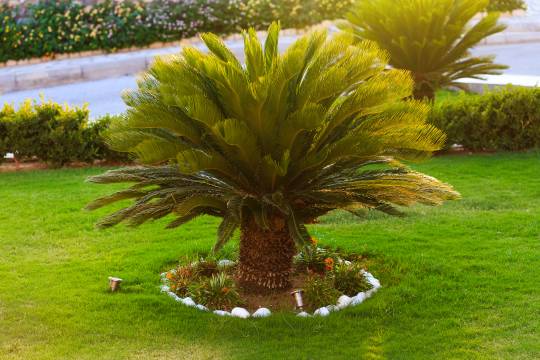Connect with a verified veterinarian in minutes. Licensed vets are available 24/7 to answer your questions. No need to worry about your furry family member.
Sago palms are popular for use in landscaping across the US, and in warmer parts of the country. However, the plant can also be grown indoors to add more ambiance to a home. However, are these plants poisonous to dogs?
Has your dog eaten sago palm? Are you worried the sago palm could make your dog sick? If so, you’ve come to the right place. We understand it can be scary when your dog eats something like this.
We’ve put together some information about sago palms and whether they can make a dog sick. Let’s get started!
What is Sago Palm?
The sago palm (Cycas revoluta) looks like a palm tree; however, these plants are not true palms! They are part of the cycad family, a group of ancient tropical plants that grow from a trunk but don’t produce branches. The plant does produce nuts but does not have flowers or fruit. Sago palms originally came from Japan and southern China.
While the plants do live outside in warmer parts of the US, they are also grown indoors as houseplants. It’s interesting that these plants grow very slowly, adding only a few inches a year.
The sago palm is a pretty plant; however, is the plant poisonous to dogs?
Sago Palm & Dogs
Unfortunately, the sago palm is toxic to dogs. All parts of the plant are poisonous; however, the seeds (nuts) are the most toxic to dogs. This is the part of the plant most dogs eat, as the nuts are easier for them to reach than other parts of the plant.
The sago palm contains several toxins that can cause severe digestive tract irritation, affect the nervous system, and damage the liver. A dog may show signs of poisoning within 15 minutes of eating the plant. Although, it may take several hours in some cases.

Review symptoms, medications & behavior to keep your pets healthy with a Vet Online in just minutes.
Ask a Vet Live NowSymptoms of Sago Palm Ingestion in Dogs
You may notice these symptoms if your dog has eaten sago palm:
- Excessive drooling
- Vomiting
- Diarrhea
- Weakness
- Seizures
- Tremors
- Abnormal fluid accumulation in the abdomen
- Abdominal pain
- Jaundice
- Black, tarry stool
If your dog shows any of these symptoms or your suspect he may have eaten sago palm, call the vet immediately. This is an emergency.
Treatment of Sago Palm Poisoning in Dogs
At the vet’s, they will work to decontaminate your dog. For instance, the vet may choose to induce vomiting and use activated charcoal to decrease the toxins in the dog’s body. They may also provide your fur baby with an IV for fluids and to make it easier to give him medications as needed.
The prognosis is best for dogs that receive prompt medical care after eating sago palm. And if you have sago palm in your home or yard, you may want to consider removing the plant since it is quite toxic to dogs.
Connect with a verified veterinarian in minutes. Licensed vets are available 24/7 to answer your questions. No need to worry about your furry family member.

Julie
Julie is a graduate of the University of North Carolina, Wilmington, where she studied Animal science. Though contrary to the opinion of her parents she was meant to study pharmacy, but she was in love with animals especially cats. Julie currently works in an animal research institute (NGO) in California and loves spending quality time with her little cat. She has the passion for making research about animals, how they survive, their way of life among others and publishes it. Julie is also happily married with two kids.
Review symptoms, medications & behavior to keep your pets healthy with a Vet Online in just minutes.
Ask a Vet Live Now

